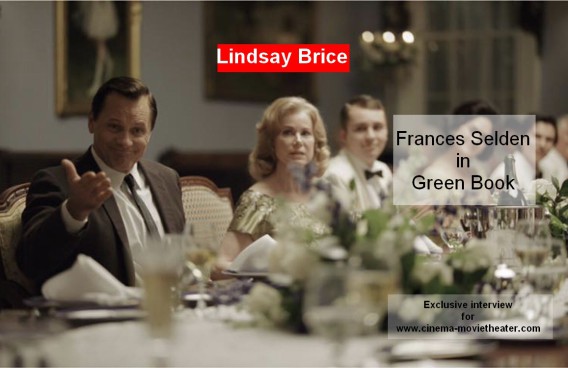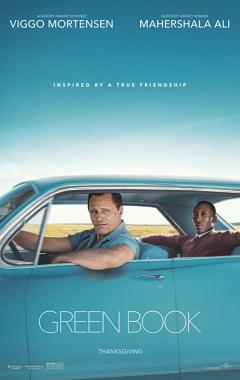
Exclusive interview with Lindsay Brice, American actress
By Jean-Paul Eliard
The February 8 th, 2019
Hi Lindsay. First, I'm very happy to do this interview with you.
Thank you. I’m delighted to talk with you about Green Book.
What did you like about the storyline and your role in Green Book?
I grew up in the Deep South, in Georgia, and I thought the script was pitch-perfect about how the South sugarcoated the harsh reality of racism in polite society in
the 1960s.
That culture was well-mannered on the surface. Racism was institutional and usually not blatant in front of other whites.
My character in Green Book is a polite Southern lady, shocked by our host’s overt racism. He announces that he asked “the help” to recommend a menu for Dr. Shirley, so he serves fried chicken and
collard greens, not what he’d serve a white guest of honor. In the final edit, that happens quickly because the point was made.
In the 1960s, white people thought they were in charge as a matter of course. Segregation seemed natural, “separate but equal” seemed a fair compromise, but that is inherently racist, and it was never equal.
It was discreet in the past, as it is in the Green Book script.
Tony and Dr. Shirley are pulled aside and told quietly that Dr. Shirley can’t eat
in the main dining room, or Dr. Shirley can’t try on a suit in the store.
This wasn’t hidden from black people, and white people who saw it pretended
to ignore it and said nothing.
Black people knew what went on, and they knew of horrors that white people didn’t know or didn’t talk about. Much is hidden in the white community, but the truth is
coming out.
The conscience of the South and of this country is a work in progress.
We’ve made progress since 1962, but lately, we’ve regressed. It’s hurtful and heartbreaking, and it’s dangerous, but maybe it’s good to see it out in
the open so we can identify it and work harder to stop it.
Dr. Shirley was heroic to tour the Deep South. That was a conscious political action. He personally knew leaders in the Civil Rights movement including Dr.
King. Dr. Shirley broke racial barriers in his unique way. He put himself in danger crossing those lines. He didn’t have to do that. He was an activist.
He was a low-key, private man, and now more of us are aware of him and his work.
There is emotion and humor in this film. How was the filming of this movie with the director Peter Farrelly and the actors Viggo Mortensen and Mahershala Ali?
The humor was not so obvious on the page. It comes from the relationship of the characters Mahershala and Viggo created. It seemed to me the characters bickered like siblings, but they were true to one another no matter how annoying one may be in a moment. They developed loyalty to one another that was unbreakable.
When I listen to recordings of the actual Dr. Shirley and Tony talking about one another, the truth in the script is affirmed.
Their relationship was deep, and that bond lasted the rest of their lives.
I recommend listening to those recordings
Peter Farrelly is brilliant, and he's a joy to be around. He has sharp insight, directs with few perfect words that make the scene work. He is open to actors’ ideas.
In the script, I tell Viggo’s character that General Lee stayed at that plantation during the Civil War.
After rehearsal, as we were walking to dinner, Pete said maybe instead of “Civil War,” I would say “The War Between the States.” I said, “How about just “The War?” In my character’s mind, the Civil
War was the only war we’d had. Pete said yes, and we went with that.
Pete’s good spirit permeated the entire production. Everyone on the team was there together with love. To be a part of that family was and is a beautiful experience.
Did you meet Mahershala Ali and Viggo Mortensen before this movie?
I’ve known Viggo many years, but we’d not acted together before. I left acting when I was young and became a photographer full-time. Viggo is also a photographer, and we connected as friends who also appreciate one another’s art. His publishing company, Perceval Press, published a book of my photographs of dolls, SuperNatural, in 2005.
Since I returned to acting a few years ago, Viggo has seen my work in short films. When he read the script, he thought of me for this role. He ran the idea past Pete,
and I was invited to audition.
I was over the moon when I got the part. I shot my scenes in December 2017, but I didn’t talk about it for a long time.
Green Book was under the radar until TIFF.
To work with Viggo was the most fun ever. We cracked up laughing after takes. We didn’t know what our characters would do next. It was a wonderful creative experience, in the moment, full of discovery and surprises. That is a dream come true for an artist.
Afterward, I realized how brilliantly Viggo took flight with this role. He researched the real Tony’s speech and behavior, then, with his imagination, he created a
new person. He released conscious ties to the actual person and to himself, and he made a new soul.
I studied with Stella Adler long ago, and what Viggo did, lifting himself with his imagination, letting go of his own personality to serve the script, was her ultimate goal in acting. When the
cameras rolled, that new person he created lived.
I first met Mahershala in the hair and makeup trailer. He is a beautiful person, deep and true, and he has a silly side, too. I adore him. Every time I see Green
Book, I see more in Mahershala’s layered performance.
Donald Shirley was elegant and urbane, yes, and then I’d hear a touch of a Pensacola accent from Dr. Shirley’s childhood. I get chills when I see and hear subtle touches Mahershala brought to that
role.
Now I’m watching Mahershala in True Detective, and his portrayal of Detective Wayne Hays in 1980, 1990, and 2015 is astonishing.Mahershala is dazzling.
When and why did you choose to be an actress?
I was shy to admit I wanted to act. In college, I was an English Literature major at Tulane. I worked in the Theatre Department finding props for Cat on a Hot
Tin Roof at antique shops on Magazine Street in New Orleans. I watched every performance on stage.
Later, I saw Alec Guinness in Tinker, Tailor, Soldier, Spy on television, and
I loved seeing the wheels turning in his mind as he did almost nothing.
I knew I wanted to act, too, and I began taking classes.
I wanted to live in New York or Los Angeles, and Los Angeles seemed more practical at the time.
On my first day there, I had an interview with Irene Gilbert at the Stella Adler Conservatory. Irene brought me to Stella, and in those two years, my foundation as an artist was set. Even in the
years I concentrated on photography, Stella’s teachings informed me as an artist.
What is your next challenge?
My demographic now, mature women, have more opportunities these days in the business. There are more roles for us now.
I am excited to explore those roles. I’ve never been a mature woman of a certain age before, it’s new to me, of course, and it’s interesting.
Thank you very much for your interview Lindsay and I wish you the best.
More information about Lindsay on her wersite LindsayBrice on IMDb,











